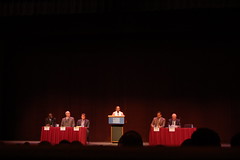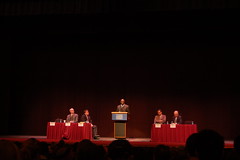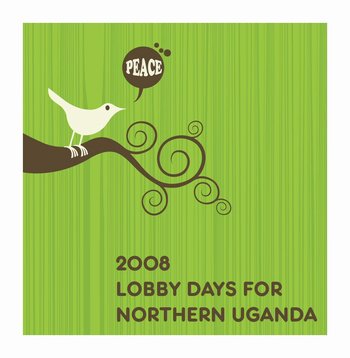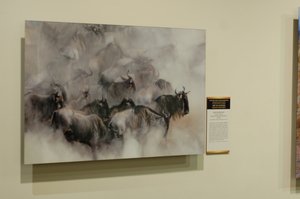by emma | Feb 29, 2008 | Social Justice
I know this is an article from a few weeks back now, but I’ve only got round to reading it today, and I love it. It’s from the Burnside Writers Collective, whom Don Miller is involved with, among others.
The article is called “The Difference Between Compassion and Justice”, check it out…
by emma | Feb 27, 2008 | Africa
As I mentioned in my last post, on Monday morning I went to the keynote panel of Uganda Lobby Day, organised by Resolve Uganda. The keynote was addressing the question, ‘How can the United States and the International Community Most Effectively Contribute to Lasting Peace in Northern Uganda?’ There were some very distinguished panelists…
Gerald LeMelle, Executive Director, Africa Action;
Timothy Shortley, Special Adviser for Conflict Resolution to Assistant Secretary of State for African Affairs Jendayi Frazer (who was on the phone from Juba, Southern Sudan, where the peace talks are taking place);
Jim Knight, Director for East Africa, U.S. State Department;
Ambassador E. Michael Southwick, former Ambassador to Uganda;
Michael Otim, Director, Gulu NGO Forum; and moderated by
Michael Poffenberger, Executive Director, Resolve Uganda.
There was a suprise guest before the panel began as well, Grace Akallo of Zion Project. You can read a bit about her here, her story is powerful.

Some points that stood out from the initial speeches…
- When asking what our role is, it’s important to recognise what we have already achieved, so as to build confidence in what we can still do. (MP)
- The Sharon statement states that the US should only do things that are in it’s own interests – So where is the debate on what the US interests are? (GLM)
- Every foreign policy issue fights for “shelf-space”, and wont be noticed unless it occupies a significant space or there is public clamor to do something. (AMS)
- Don’t settle for a B-effort for an A-cause. Don’t confuse rhetoric with results. (AMS)

[Michael Otim]
After the individual speeches, there was an open Q&A time, which raised some very interesting questions…
- Regarding the role of the ICC (Positive/Negative?): The pressure for accountability [due to arrest warrants issued by the ICC for the top 5 LRA leaders] is partially what caused the LRA to enter peace talks. However, national trials are also very important in giving ownership of the process to Ugandan citizens. (MO)
- Regarding military intervention: Would only complicate things, should exhaust every other option first. However there is a “Responsibility to Protect” doctrine, which grew out of the Rwandan genocide. (AMS)
- Amnesty vs Accountability: Is forgiveness a good option, which then allows combatants to come out of the bush and reintegrate into the community? Forgiveness happens in Africa, unlike in most of the western world. We also need to take into account the complexities of the conflict – a lot of child soldiers where abducted unwilling. (MO) We should not allow issues to carry on longer than necessary, but allow African forms of justice to deal with the combatants. (AMS)
This last point was the main one I’ve been struck by and am thinking through. I’ll let you know if I have any further developed thoughts on this!
by emma | Feb 25, 2008 | Africa

I’m heading over to George Washington University for the Uganda Lobby Day keynote. I love that since I booked this trip I found out about lots of other great stuff going on that I’ve got to be a part of too. I’m excited about this, especially after news that the LRA signed a peace agreement yesterday (I think… can’t find verification anywhere…?).
by emma | Feb 25, 2008 | Travel
I’ve spent the last few days taking in lots of creativity here… from photography to sculpture to painting and everything in between.
On Friday I went to the Natural History Museum to see an exhibition titled Nature’s Best Photography. There were some really stunning images, although I must confess my favourite wasn’t a winner but a highly commended one. I can’t remember the photographers name, but here’s the image…

On Saturday after watching the game (did I mention, 34-13?!) I headed to the National Portrait Gallery / American Art Museum with the intention of seeing Let Your Motto Be Resistance again, which I did. I also however, managed to read lots of quotes which they have all over the walls (I love quotes!), and see an exhibition of art by John Alexander. I’d never heard of Alexander before, but apparently he is “internationally renowned for his paintings and drawings, which convey humor, rage and a robust appreciation of the human and natural world.” I really like his stuff. He has the most eclectic style, you would hardly guess from looking at one painting to the next that they were both his. The three images below are all from his work…



I also found this really interested painting by a guy called Howard Finster, titled “The Lord Will Deliver His People Across Jordan”. The Reverend Howard Finster (December 2, 1916- October 22, 2001) was a folk artist from Summerville, Georgia who claimed to be inspired by God to spread the gospel through the environment of Paradise Garden and over 46,000 pieces of art [via wikipedia].

[View large here to see more details.]
All in all quite an interesting few days of artistic experiences!
by emma | Feb 24, 2008 | Everything Else

Was answered resoundingly today!
Ireland 34 – 13 Scotland










Recent Comments